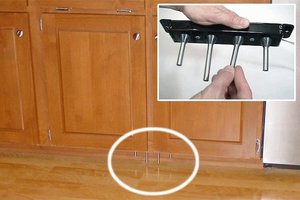 What Would MacGyver Do? 4 Clever DIY Projects to Save Water, Energy, and Money
What Would MacGyver Do? 4 Clever DIY Projects to Save Water, Energy, and Money
Save yourself some money while doing your part for the environment–MacGyver style.
How would MacGyver apply his genius to find resourceful solutions to save energy, water, and money around the house? Many handy home owners have already figured it out. All over the web, inventive people are sharing the fruits of their at-home handiness. We found four of the most clever, creative tricks that will please your inner MacGyver while helping you go green.
Save water: Outfit the kitchen faucet with a foot pedal
As this Instructables contributor points out, wasting water is wasting resources, so he’s come up with an innovative way to control how much water you use. By installing solenoid valves–pipe fittings souped up with a valve that opens and closes when electricity is applied–and then wiring them to a foot pedal, there’s no more wasted water. Just toe-tap the valve closed when you’re soaping up pots and pans, then tap the valve open when it’s time to rinse. The set-up’s relatively easy to do, without plumbing expertise required, and very MacGyver, indeed.
Materials you’ll need:
- A pair of 12V DC solenoid valves
- Pedal
- At least 12 feet of electrical wire
- 12V DC adapter
- Electrical tape
Tools to have on-hand:
- Adjustable wrench
- Wire strippers
See the full how-to from Instructibles contributor pjamestx.
Save energy: Build a wind turbine on the cheap
As an alternative energy source, wind turbines are a good way to make money off your home by selling the energy back to the utility. Unfortunately, wind turbines require a hefty upfront investment. What would the MacGyver in you do when faced with such a huge expenditure? Save money by building your own, of course! (Word of caution, though: this isn’t for the average MacGyver DIY-er. If you don’t understand the safety precautions of installing and using a wind turbine, don’t attempt). But it is inspiring to see that one can be built with reused materials. And if you do install one, talk to your local utility before banking on making big bucks. The standards for selling energy vary by state.
Materials you’ll need:
- Generator
- PVC or ABS pipe, cut into blades
- Toothed pulley and disk of aluminum to connect the blades
- A 2×4 piece of wood and a 2-foot diameter disk of plywood
- Aluminum sheet for the tail
- 1″ diameter iron pipe
- 1¼-diameter steel EMT electrical conduit
- Steel stakes for securing in the ground
- Batteries
- An electronic charge control system
- Various small hardware pieces
Tools to have on hand:
- Belt or palm sander
- Drill that can cut into metal
- Saw for wood and PVC pipe
See the full how-to by DIY enthusiast Mike Davis.
Save space: Build a convenient recycling chute
If MacGyver was short on kitchen space for recycling bins, we could picture him building this creative solution that lets you send your cans to a recycling bin in your basement without having to run up and down stairs. Carefully plan where to install the chute, and make sure you have room in your basement to correctly position the recycling bin. The home owner who posted this Instructable cut a hole in the floor of a kitchen cabinet.
Materials you’ll need:
- 3 1/2″ PVC pipe (fits soda cans)
- A piece that connects the pipes, angled if you can’t do a straight drop
- Glue
Tools to have on hand:
- Sawzall or 3 1/2″ or 4″ hole saw with drill
- Screwdriver
- 1/8″ drill bit
- Saw to cut pipe
See the full how-to by Instructibles contributor The Goose.
Save on paint: Mix up your own with milk
The Environmental Protection Agency classifies paint as one of the top five hazardous substances. While you likely can’t avoid paint altogether, for small jobs and ones meant to have a rustic aesthetic quality, you can always make your own.
Materials you’ll need for enough to cover a bureau:
- Juice of one lemon
- 1 quart of skim milk
- 4 tablespoons of dry color pigment or artist’s acrylic paint
Tools to have on-hand:
- Sieve
- Cheesecloth
- Large bowl
- Brush or paint roller
See the full how-to by Martha Stewart.
Going green doesn’t have to be hard or expensive. It can be easy, cheap, and fun. To get your MacGyver on, see more easy green projects at HouseLogic. Below are just a few, but check out our articles on going green for more.
Read more: http://members.houselogic.com/articles/what-would-macgyver-do-4-clever-diy-projects-save-water-energy-and-money/preview/#ixzz32O1jTbdE
Follow us: @HouseLogic on Twitter | HouseLogic on Facebook
 Facebook
Facebook
 Twitter
Twitter
 Pinterest
Pinterest
 Copy Link
Copy Link


